by Jane
I remember when the Chernobyl disaster happened. I was in first grade. I clearly remember drawing pictures, showing how we needed to keep our windows closed to prevent radiation from coming in. I was living in Florida at the time, so that was probably somewhat silly, but then again, I was seven years old at the time – it’s a wonder Chernobyl was even on my radar.
Of course, I didn’t really think about Chernobyl much at all after first grade. It was something I knew about, something I was aware of, but – despite spending my undergrad years studying the former Soviet Union – I gave it very little thought whatsoever until 2004.
In 2004, I came across that semi-hoax website, Kidd of Speed. (I call it a semi-hoax, as the photos are genuine, but initially the author had this long, involved story, about having been given permission to ride solo through the Zone on her motorcycle; this wasn’t true – she had gone to the zone as part of a tour.) Looking at the photos on the Kidd of Speed website, I immediately became hooked on the notion of going and seeing what was left of the Chernobyl reactor and the nearby city of Pripyat for myself. It wasn’t until August 2011 that I got the opportunity.
Back in 2010, several of us from over here at Desolation Travel decided we should meet up somewhere good and desolate. While we all would have loved to have returned to Kyrgyzstan, flights there were simply too expensive. We tossed around several ideas, before settling on meeting in Kiev in August 2011, and trekking out to Chernobyl.
Chernobyl is – allegedly – safe to visit. Allegedly, the dose of radioactivity one receives while on a day trip out of Kiev is equivalent to what you’d get from a long-haul overseas flight. Of course, in the space of six weeks I’ll have taken three such flights, gone to Chernobyl, and had dental x-rays, so I’m pretty sure I’ve exceeded ‘proper’ radiation levels. Meh. No physical harm.
You can’t just stroll on into the Zone whenever you want. You have to have permission from the Ukrainian government. The easiest way to visit the Zone is via a tour agency. There are several agencies out of Kiev which book tours to the Zone, and which arrange all the necessary paperwork. It can be done fairly quickly (assuming there’s space available), and with very little hassle on the part of the tourist. This costs between $150-$200, depending on what agency you use. We used Solo-East. If you have the time and money, you can apply for your own permit. I’ve heard it can take about three weeks to process. You’ll also have to arrange your own transportation and hire a government approved guide/monitor. I don’t see much reason to do that, myself, as it would end up being far more expensive, and you’d probably see exactly what you’d see as part of a tour.
The trip from Kiev to Chernobyl takes between an hour and a half and two hours, depending on the traffic in and around Kiev. The tour ‘bus’ (a mini-van) we were on had a television, which showed the documentary The Battle of Chernobyl – and excellent documentary, which you can watch in its entirety here for free. I highly recommend it to anyone who is even remotely interested in Chernobyl, nuclear power, and/or the former Soviet Union.
The movie finished just a few minutes before we arrived at the first checkpoint. The first thing that struck me was that farmland – active, arable farmland – went right up to the border with The Zone. It’s not like radiation just stops and says ‘oh, here’s the edge of The Zone, I’d better not flit across this line and contaminate those cows.’ But I guess you have to draw a line somewhere. Or in the case of Chernobyl, two lines – one at 30km from the reactor, and one at 10km.
The first checkpoint is located 30km from the reactor, at the entrance to the exclusion zone. No photos allowed. (Hah.) Here you will have your passports checked against the list of people who have been approved for entrance into the zone.
Of course, I didn’t really think about Chernobyl much at all after first grade. It was something I knew about, something I was aware of, but – despite spending my undergrad years studying the former Soviet Union – I gave it very little thought whatsoever until 2004.
In 2004, I came across that semi-hoax website, Kidd of Speed. (I call it a semi-hoax, as the photos are genuine, but initially the author had this long, involved story, about having been given permission to ride solo through the Zone on her motorcycle; this wasn’t true – she had gone to the zone as part of a tour.) Looking at the photos on the Kidd of Speed website, I immediately became hooked on the notion of going and seeing what was left of the Chernobyl reactor and the nearby city of Pripyat for myself. It wasn’t until August 2011 that I got the opportunity.
Back in 2010, several of us from over here at Desolation Travel decided we should meet up somewhere good and desolate. While we all would have loved to have returned to Kyrgyzstan, flights there were simply too expensive. We tossed around several ideas, before settling on meeting in Kiev in August 2011, and trekking out to Chernobyl.
Chernobyl is – allegedly – safe to visit. Allegedly, the dose of radioactivity one receives while on a day trip out of Kiev is equivalent to what you’d get from a long-haul overseas flight. Of course, in the space of six weeks I’ll have taken three such flights, gone to Chernobyl, and had dental x-rays, so I’m pretty sure I’ve exceeded ‘proper’ radiation levels. Meh. No physical harm.
You can’t just stroll on into the Zone whenever you want. You have to have permission from the Ukrainian government. The easiest way to visit the Zone is via a tour agency. There are several agencies out of Kiev which book tours to the Zone, and which arrange all the necessary paperwork. It can be done fairly quickly (assuming there’s space available), and with very little hassle on the part of the tourist. This costs between $150-$200, depending on what agency you use. We used Solo-East. If you have the time and money, you can apply for your own permit. I’ve heard it can take about three weeks to process. You’ll also have to arrange your own transportation and hire a government approved guide/monitor. I don’t see much reason to do that, myself, as it would end up being far more expensive, and you’d probably see exactly what you’d see as part of a tour.
The trip from Kiev to Chernobyl takes between an hour and a half and two hours, depending on the traffic in and around Kiev. The tour ‘bus’ (a mini-van) we were on had a television, which showed the documentary The Battle of Chernobyl – and excellent documentary, which you can watch in its entirety here for free. I highly recommend it to anyone who is even remotely interested in Chernobyl, nuclear power, and/or the former Soviet Union.
The movie finished just a few minutes before we arrived at the first checkpoint. The first thing that struck me was that farmland – active, arable farmland – went right up to the border with The Zone. It’s not like radiation just stops and says ‘oh, here’s the edge of The Zone, I’d better not flit across this line and contaminate those cows.’ But I guess you have to draw a line somewhere. Or in the case of Chernobyl, two lines – one at 30km from the reactor, and one at 10km.
The first checkpoint is located 30km from the reactor, at the entrance to the exclusion zone. No photos allowed. (Hah.) Here you will have your passports checked against the list of people who have been approved for entrance into the zone.
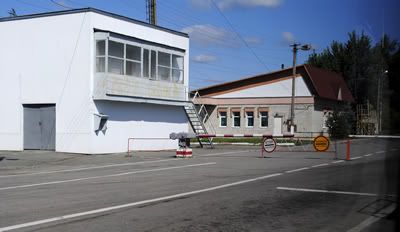
First checkpoint - no photos allowed! :-)
The small town of Chernobyl is located within the 30km exclusion zone – a pleasant, green swath of countryside, which looks as though it would be a wonderful, peaceful, rural place to live. Roughly 4000 people currently live in the town of Chernobyl. Most are there as part of the ongoing maintenance of the #4 reactor (the one that exploded), although others are there to maintain the other three reactors – two of which remained functional until 2000. When you see how close they are to reactor #4, you’ll find this fact utterly mind-boggling. There are also plenty of scientists living in Chernobyl, conducting experiments on the effects of radiation on the local wildlife and whatnot, as well as support staff… and quite a few elderly folks who returned after having been ‘resettled’ following the accident.
In an office building in the city of Chernobyl, we were required to sign a waiver, essentially saying that if we get fucked up in any way on account of having visited the Chernobyl zone, we cannot sue the Ukrainian government. Okeedokee.
In an office building in the city of Chernobyl, we were required to sign a waiver, essentially saying that if we get fucked up in any way on account of having visited the Chernobyl zone, we cannot sue the Ukrainian government. Okeedokee.
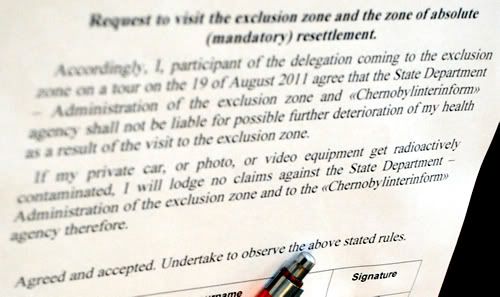
After signing the waiver, we got back in the bus and headed for the 10km line, demarking the Zone of Mandatory Resettlement. No one legally lives within the 10km zone, although there are squatters, scavengers, and elderly people who have returned to the villages of their youth. Sadly, we were unable to meet any of these folks. That is something that I would really like to do at some point, although I’m not sure how feasible it is.
I wasn’t really sure what to expect from our tour. I’d kind of expected a highly monitored tour, with lots of ‘stand here and look at this’ and ‘stand here and look at that.’ I didn’t expect to be allowed to run free at any point. I also didn’t think that we’d be getting anywhere close to the #4 reactor itself. As such, when we came upon our first glimpse of the reactors, I took a TON of photographs. Little did I know that I’d be getting MUCH closer! I’ll just post a handful of those I took:
I wasn’t really sure what to expect from our tour. I’d kind of expected a highly monitored tour, with lots of ‘stand here and look at this’ and ‘stand here and look at that.’ I didn’t expect to be allowed to run free at any point. I also didn’t think that we’d be getting anywhere close to the #4 reactor itself. As such, when we came upon our first glimpse of the reactors, I took a TON of photographs. Little did I know that I’d be getting MUCH closer! I’ll just post a handful of those I took:
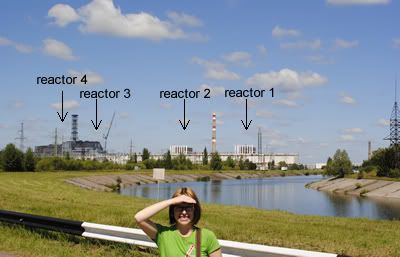
Yep, that's me. And reactors #1 and #2? They remained in operation until 2000. That is mind-boggling to me on so many levels. I mean, if Pripyat (the town 3km away) was abandoned, how could it have possibly been deemed a good idea to keep people working just a few hundred meters from reactor #4?
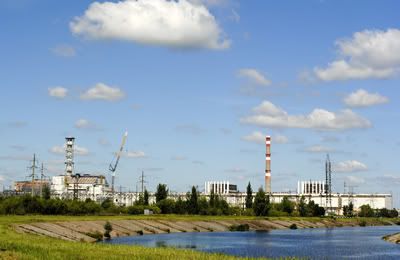
Same scene, sans goofy tourist
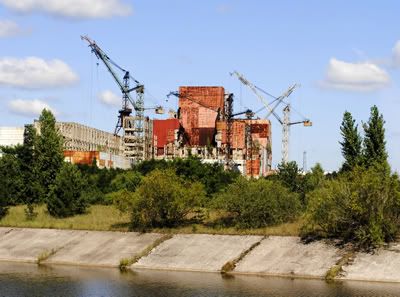
From the same vantage point, this could be seen. It would have been reactor #5. It was under construction at the time of the explosion at reactor #4, and was never completed.
From there we went to Pripyat. For those who don’t know, Pripyat was built in 1970, for the sole purpose of housing workers at the Chernobyl nuclear plants, their families, and all the people necessary to support them (teachers, store clerks, etc). Depending on your source, Pripyat was home to between 43,000 and 50,000 people at the time of the explosion at reactor #4 in April 1986. The town was located a mere 3km from the reactor, and yet was not evacuated until the third day following the explosion. Residents were told that they would only be gone for a few days… yet the evacuation was permanent. The town has been slowly reclaimed by nature over the years.
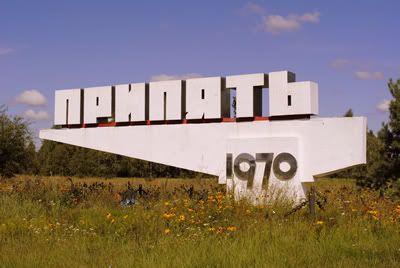
It’s weird, visiting Pripyat. A town of 43,000-50,000 people is fairly large… but in this case, it’s difficult to actually see how large the town would have been, as so much of it is now obscured by tree growth. It’s also bizarre to imagine that the town was evacuated in order to avoid the devastating effects of radiation. Plant life, at the very least, is teeming. (The Zone is supposedly rich in wildlife as well, although unfortunately we saw only spiders, pigeons, and catfish.) There is nothing about Pripyat – other than its emptiness – to give any hint as to the disaster that befell them. If one were seriously lost, and somehow stumbled upon the city, it would be a thoroughly bewildering experience. It just seemed so normal. Except that it was empty. Like roughly fifty thousand people just left one morning and never returned.
I had expected that we would be very limited in terms of what we could do and where we could go while inside Pripyat. That was not the case at all. While we were taken on a somewhat organized route through the city (main square, amusement park, palace of culture, Hotel Polissya, sports center, school), we were allowed to essentially go wherever and do whatever we wanted. The only rule was ‘Don’t step on the moss!’ as apparently moss holds far more radiation than asphalt or dirt or grass. Or so we were told anyway.
Pripyat is a photographer’s dream, especially if you’re someone who is into photographing desolation, decay, or urban blight. I am, and I loved every minute of my time there. I mean no disrespect to those who used to live there or their families by this. I truly feel that images of what can happen if/when nuclear power gets out of hand MUST be shown to the world. This is something that everyone should see – especially proponents of nuclear power. It’s a grim, serious, and depressing reality. But as a photographer, I loved it. I have far too many photos from Pripyat to post below. To see my complete set of Pripyat photos, CLICK HERE.
I had expected that we would be very limited in terms of what we could do and where we could go while inside Pripyat. That was not the case at all. While we were taken on a somewhat organized route through the city (main square, amusement park, palace of culture, Hotel Polissya, sports center, school), we were allowed to essentially go wherever and do whatever we wanted. The only rule was ‘Don’t step on the moss!’ as apparently moss holds far more radiation than asphalt or dirt or grass. Or so we were told anyway.
Pripyat is a photographer’s dream, especially if you’re someone who is into photographing desolation, decay, or urban blight. I am, and I loved every minute of my time there. I mean no disrespect to those who used to live there or their families by this. I truly feel that images of what can happen if/when nuclear power gets out of hand MUST be shown to the world. This is something that everyone should see – especially proponents of nuclear power. It’s a grim, serious, and depressing reality. But as a photographer, I loved it. I have far too many photos from Pripyat to post below. To see my complete set of Pripyat photos, CLICK HERE.

Palace of Culture "Energetic"

Inside the Palace of Culture
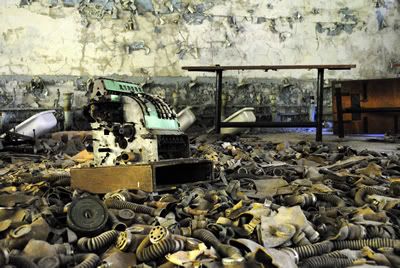
Inside the school
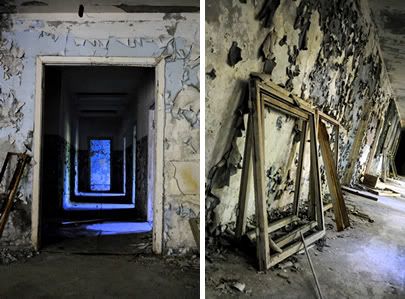
Also inside the school
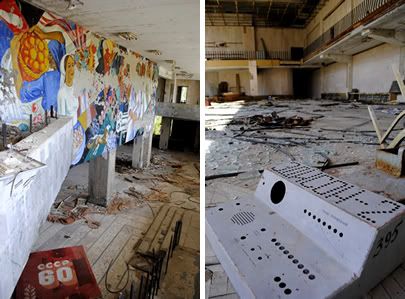
More from the Palace of Culture
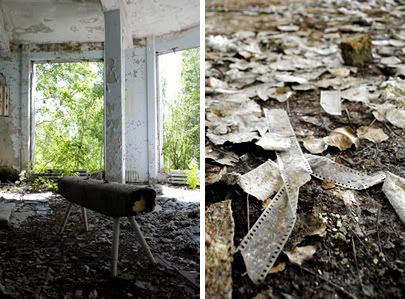
Left: a gymnastics horse from the sports center
Right: Irradiated negatives from the Hotel Polissya
A tour like this would never be legal in the United States, where both safety concerns and the potential for lawsuits are huge. Not only were we 3km from the world’s most famous nuclear disaster, but as you can tell from the photos, we were exploring decaying – and not entirely safe – buildings. Broken glass was everywhere. Rotted floorboards were common. As were piles of what looked suspiciously like asbestos. And sketchy things dangling from – and dropping from – ceilings. I loved it. And it would so never fly in the US.
After thoroughly exploring Pripyat, it was time for lunch. We were taken to the cafeteria that’s located on site to feed those working at the power station, where we ate *quite* a tasty lunch of locally produced food. Safety, shmafety. Before we were allowed into the cafeteria proper, we had to pass through this lovely radiation detection device:
After thoroughly exploring Pripyat, it was time for lunch. We were taken to the cafeteria that’s located on site to feed those working at the power station, where we ate *quite* a tasty lunch of locally produced food. Safety, shmafety. Before we were allowed into the cafeteria proper, we had to pass through this lovely radiation detection device:
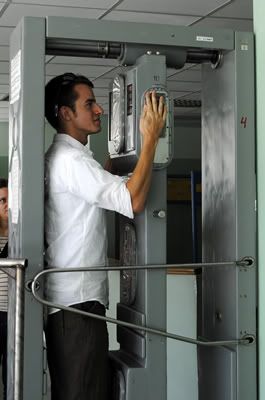
No one ever said what happens if you register ‘contaminated’ though!

One fellow on the tour was a vegetarian, though, and he had a bit of a rough go of the lunch. Very much an Everything is Illuminated kind of moment. How do you make beef soup vegetarian? Scoop out the chunks of beef. Hah.
After lunch, our next stop was to feed the radioactive catfish. I find fish kind of boring, and while there were a couple of behemoths that surfaced a handful of time, for the most part, they just looked like fish. Yawn. On to the reactor!
Between the catfish feeding and the reactor, we passed a sign on a building that said NUKEM. Sadly, none of us was prepared to snap a picture. NUKEM? Talk about a seriously bad choice of name. It’s a German/American civil nuclear fuel company, that’s apparently involved in the maintenance of the facility.
Okay, okay. On to the reactor!
We were able to stand approximately 100m from the sarcophagus covering reactor #4… and the thing is, it all seemed so normal. There were people working at the other parts of the facility. There were buses ferrying workers about, people walking, driving. The weather was gorgeous. It looked just like any factory anywhere might. Get out of the developed world, and there are plenty of places that look much worse yet are still producing whatever it is they produce. This didn’t look dangerous at all. It just looked… normal. That was what made it creepy. If no one told you what it was, you’d have no clue. It wasn’t pulsating or glowing. It didn’t emit a smell or a sound. And yet it was emitting radiation. We weren’t allowed to stay in that spot too long.
After lunch, our next stop was to feed the radioactive catfish. I find fish kind of boring, and while there were a couple of behemoths that surfaced a handful of time, for the most part, they just looked like fish. Yawn. On to the reactor!
Between the catfish feeding and the reactor, we passed a sign on a building that said NUKEM. Sadly, none of us was prepared to snap a picture. NUKEM? Talk about a seriously bad choice of name. It’s a German/American civil nuclear fuel company, that’s apparently involved in the maintenance of the facility.
Okay, okay. On to the reactor!
We were able to stand approximately 100m from the sarcophagus covering reactor #4… and the thing is, it all seemed so normal. There were people working at the other parts of the facility. There were buses ferrying workers about, people walking, driving. The weather was gorgeous. It looked just like any factory anywhere might. Get out of the developed world, and there are plenty of places that look much worse yet are still producing whatever it is they produce. This didn’t look dangerous at all. It just looked… normal. That was what made it creepy. If no one told you what it was, you’d have no clue. It wasn’t pulsating or glowing. It didn’t emit a smell or a sound. And yet it was emitting radiation. We weren’t allowed to stay in that spot too long.
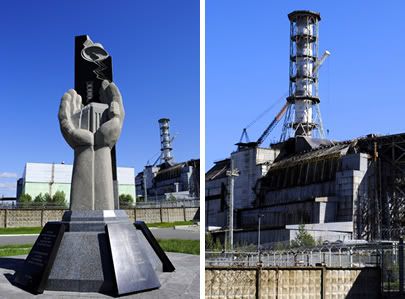
Left: A monument to those who died, which appears to be holding a TARDIS.
Right: The reactor, up close and personal.
To see the complete set of all my other Chernobyl photographs, CLICK HERE.

No comments:
Post a Comment